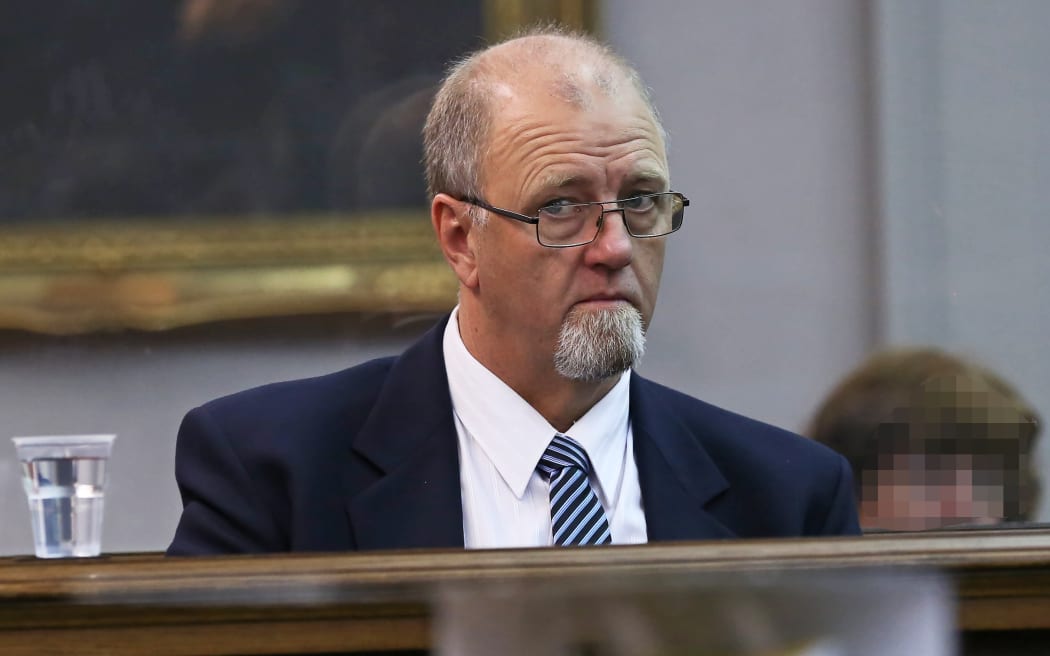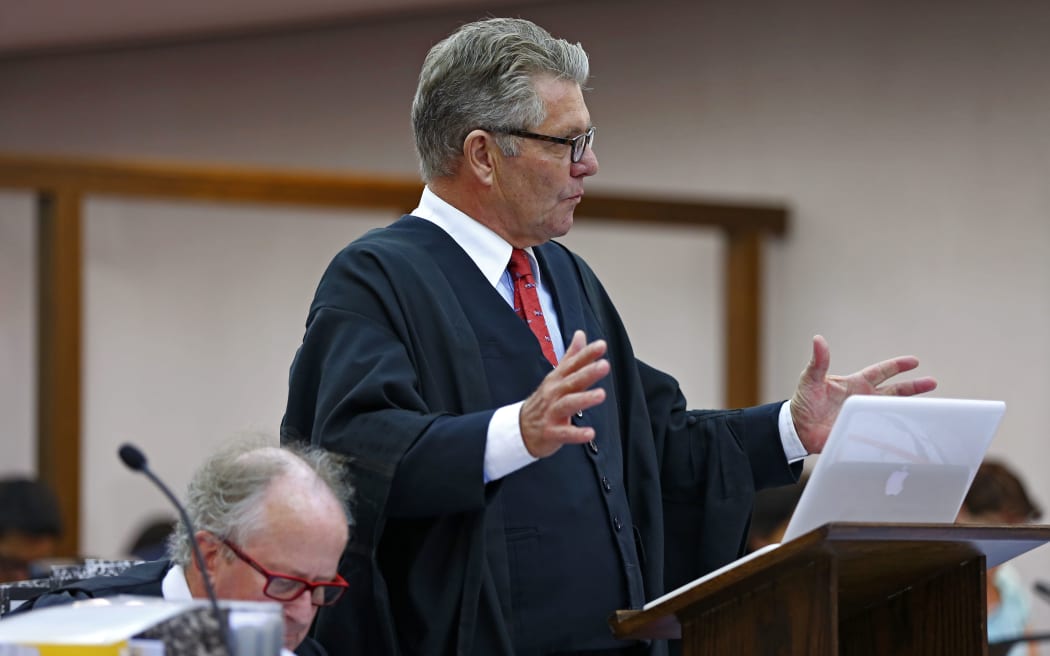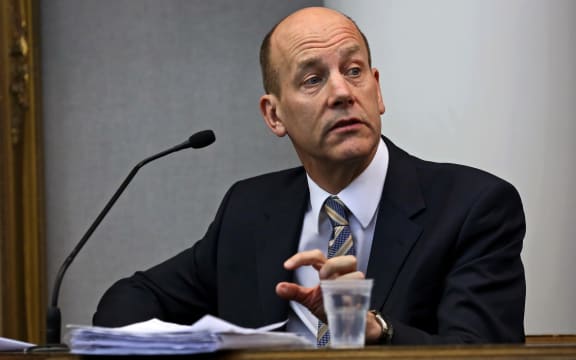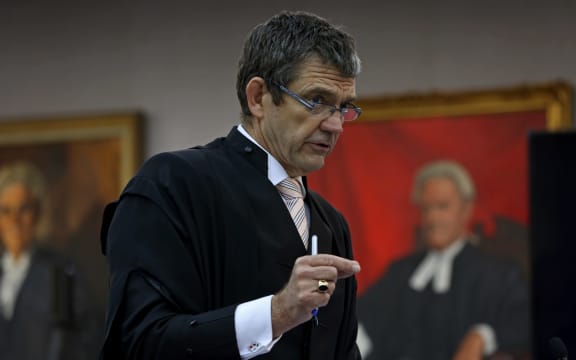Mark Lundy told a fellow inmate he was in jail because his daughter had seen what he was doing to his wife, the High Court at Wellington has been told.

Mark Lundy in court this morning. Photo: RNZ / Alexander Robertson
Mr Lundy, 56, denies murdering Christine and Amber Lundy, whose bodies were found in their Palmerston North home on 30 August 2000; the Crown claims Mr Lundy killed his 38-year-old wife for her insurance money and his seven-year-old daughter because she saw what he was doing to her mother.
Key points from Day 27:
A man known as Witness X, who has name suppression, told the court he was in jail in 2002 when he met a man called Mark.
He told the man his crime and said he would not be there if his mother had not reported him to the police.
The man then revealed what he was in jail for.
"He said he wouldn't be in there if his daughter hadn't come out and seen what he was doing to his wife," Witness X said.
"He told me that he'd been planning his for a while and she had it coming to her.
"I just thought he was in there for beating his wife up or something."

Defence lawyer Ross Burns, pictured earlier in the trial. Photo: RNZ / Alexander Robertson
Witness X changed units soon after and forgot about the conversation until he saw a 2013 news item about Mr Lundy being released after successfully appealing his conviction to the Privy Council.
He said he had a "flashback" to the 2002 conversation and rung police to tell them about it.
Asked why he was giving evidence, he said: "It's the right thing to do. That's all it is."
Defence lawyer Ross Burns said the man had a number of dishonesty convictions and asked who it was the right thing for - himself or the wider community.
"In this case, the right thing to do for the mother and for the daughter," Witness X said.
But Mr Burns queried the timing of Witness X's flashback, saying he had breached a protection order the day before he saw the news item and, given his record, faced the prospect of a return to prison.
He wanted to get into segregation should he go back to prison because of another case he had been involved in, and the best way of doing that was by "narking" on Mr Lundy, Mr Burns said.
Asked whether he considered himself to be an honest man, Witness X said not in the past but that he was telling the truth today.
"I've made some mistakes, everyone does. I'm just here to talk about the conversation I had with Mark Lundy."
But Mr Burns accused him of being manipulative, saying he had claimed his conversation with Mr Lundy occurred while Mr Lundy was awaiting a decision on his sentence appeal; in fact, the only chance Witness X had to see him was before Mr Lundy had been convicted, the lawyer said.
"Are you just being manipulative again. Has the booze affected your memory," Mr Burns asked, to which Witness X replied: "No, not at all."
Mad cow expert at Lundy trial
Earlier today, defence witness Professor James Ironside, a professor of medical neuropathology at the University of Edinburgh told the court it was not possible to say whether a substance found embedded in Mr Lundy's polo shirt and which several experts have identified as CNS tissue from the brain or spinal cord came was human.

Professor James Ironside Photo: RNZ / Alexander Robertson
"It could be human but it could originate from other mammalian species," Prof Ironside said.
CNS tissue from animals could enter the human food chain, and Prof Ironside said that was a possibility he could not dismiss.
Asked by Justice Simon France to clarify what he meant, Prof Ironside said food, especially meat, had been found to contain CNS if it was made in a certain way and gave the example of lamb neck chops in which the spinal cord could sometimes be seen.
"You're not buying it to eat the spinal cord, you're buying it to eat the meat, but the spinal cord is there."

Crown lawyer Philip Morgan, QC, Photo: RNZ / Alexander Robertson
Prof Ironside agreed with Crown lawyer Philip Morgan, QC, that his findings were the same as those of five other experts on the tissue embedded into the shirt.
Mr Morgan: "There just can be no doubt at all that its central nervous system tissue, brain or spinal cord."
Prof Ironside: "Correct."
However, the experts also agreed that tissue found on the shirt but not embedded, and which Institute of Environmental and Scientific Research scientist Bjorn Sutherland took dab slides from, was too degraded to say with certainty what it was from, Mr Morgan said.
"I think we've reached the same conclusion," Prof Ironside said.
Mr Morgan put it to Prof Ironside that for that tissue to be different to the CNS embedded in the shirt, another substance would have needed to land directly on the CNS and then be cleanly wiped off by the dab slide process.
"Don't you think, actually, it's a bit too silly for words," Mr Morgan said.
Prof Ironside: "I don't think it's silly and I don't think it should be dismissed."
Mr Morgan also asked him how, if the CNS was from an animal through processed food, there was no sign of matter such as gristle and smooth muscle cells. Instead, the CNS was "raw, fresh CNS tissue and nothing else. Is that right".
Prof Ironside said it depended on the food preparation and what else was used in the process.
Defence lawyer David Hislop, QC, asked Prof Ironside whether those other elements could have been washed off in the process of making the dab slides, leaving only the CNS.
Prof Ironside said that was possible, especially as CNS was of a softer structure and was more likely to become embedded in fabric.
Clarification - For the avoidance of doubt, please note that Radio New Zealand reporter Sharon Lundy is no relation to Mark Lundy.


